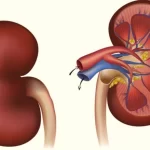Liver thrombosis, also known as hepatic vein thrombosis or Budd-Chiari syndrome, is a condition characterized by the formation of blood clots in the veins that carry blood away from the liver. The underlying cause of liver thrombosis can vary, but it often results from a combination of factors. Here are some possible reasons:
Hypercoagulable states:
Certain medical conditions and genetic disorders can increase the risk of blood clot formation. Conditions such as polycythemia vera, paroxysmal nocturnal hemoglobinuria, myeloproliferative disorders, and deficiencies in anticoagulant proteins like protein C, protein S, or antithrombin III can predispose individuals to liver thrombosis.
Liver diseases:
Liver conditions that cause scarring and disruption of blood flow within the liver can contribute to thrombosis. Cirrhosis, liver cancer, liver abscesses, and hepatitis B or C infections are examples of liver diseases that can increase the risk of blood clot formation.
Pregnancy and the postpartum period:
During pregnancy, hormonal changes, increased blood volume, and compression of blood vessels can lead to a higher risk of blood clotting. Pregnancy-related liver thrombosis is relatively rare but can occur. The postpartum period is also associated with an increased risk of thrombosis.
Trauma or surgery:
Liver thrombosis can develop as a complication of abdominal trauma or surgery. The manipulation of blood vessels during surgical procedures or direct injury to the liver can trigger clot formation.
Medications and contraceptives:
Certain medications, such as oral contraceptives, hormone replacement therapy, and tamoxifen, can increase the risk of blood clots. These medications can alter blood coagulation and predispose individuals to liver thrombosis.
It’s important to note that the causes and risk factors mentioned above are not exhaustive, and liver thrombosis can sometimes occur without an identifiable cause. The condition requires medical evaluation and treatment to manage the clotting disorder and address any underlying conditions contributing to its development.
liver thrombosis treatment
The treatment of liver thrombosis, or hepatic vein thrombosis, aims to prevent the formation of new blood clots, dissolve existing clots, and manage any underlying conditions contributing to the clotting disorder. The specific treatment approach may vary depending on the severity of the thrombosis and individual patient factors. Here are some standard treatment options:
Anticoagulant therapy:
Anticoagulant medications, such as heparin or warfarin, are often prescribed to prevent further clotting and promote the dissolution of existing clots. These medications work by inhibiting the formation of blood clots and preventing their extension. The duration and type of anticoagulation therapy may vary based on the underlying cause and individual patient factors.
Thrombolytic therapy:
In some cases, thrombolytic therapy may be used to dissolve the blood clot. Thrombolytic agents, such as tissue plasminogen activator (tPA), are administered intravenously to break down the clot and restore blood flow. This approach is typically reserved for severe cases or when anticoagulation alone is insufficient.
Transjugular intrahepatic portosystemic shunt (TIPS):
TIPS is a procedure that involves the placement of a stent-like device to create a connection between the portal vein (which carries blood from the intestines to the liver) and the hepatic vein (which carries blood away from the liver). TIPS helps to bypass the blocked or narrowed hepatic veins, reducing pressure within the liver and improving blood flow. It is often used in cases of chronic or recurrent liver thrombosis.
Surgical intervention:
In certain situations, surgical procedures may be necessary to address liver thrombosis. This may involve removing the clot directly, repairing or bypassing damaged blood vessels, or liver transplantation in severe cases where the liver is significantly compromised.
Management of underlying conditions:
Treating and managing any underlying liver diseases, such as cirrhosis or hepatitis, is essential in managing liver thrombosis. This may involve lifestyle modifications, medications, or specific interventions targeted at the underlying condition.
A healthcare professional with expertise in hepatology or vascular medicine best makes treatment decisions. The approach to treatment will depend on the individual patient’s situation and requires a comprehensive evaluation of their medical history, the extent of thrombosis, and the underlying factors contributing to the condition.






